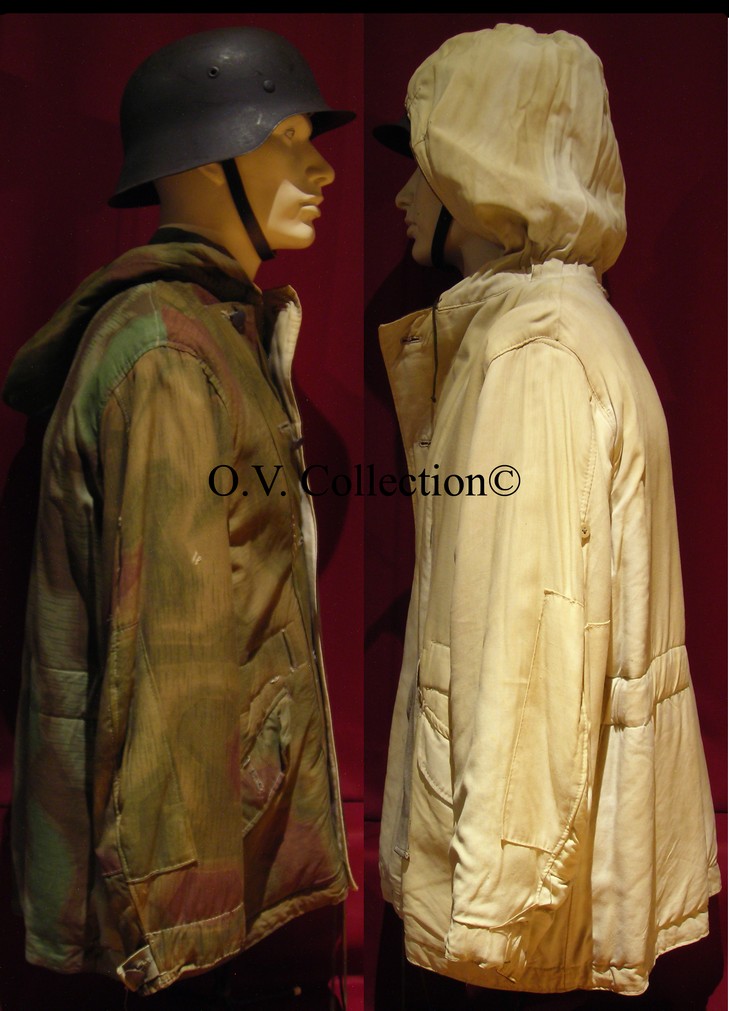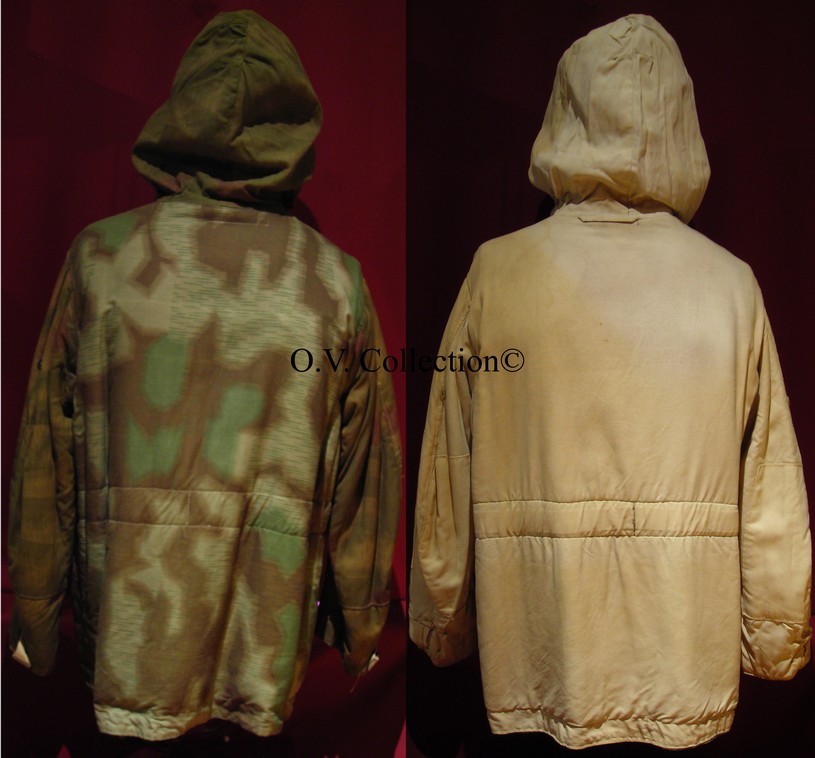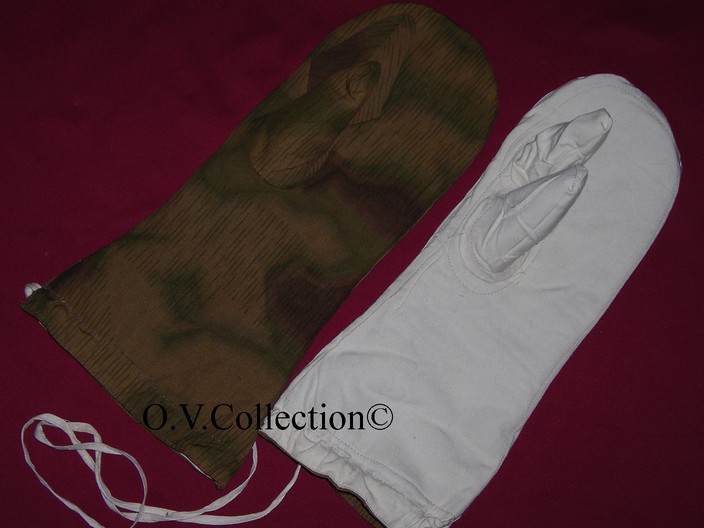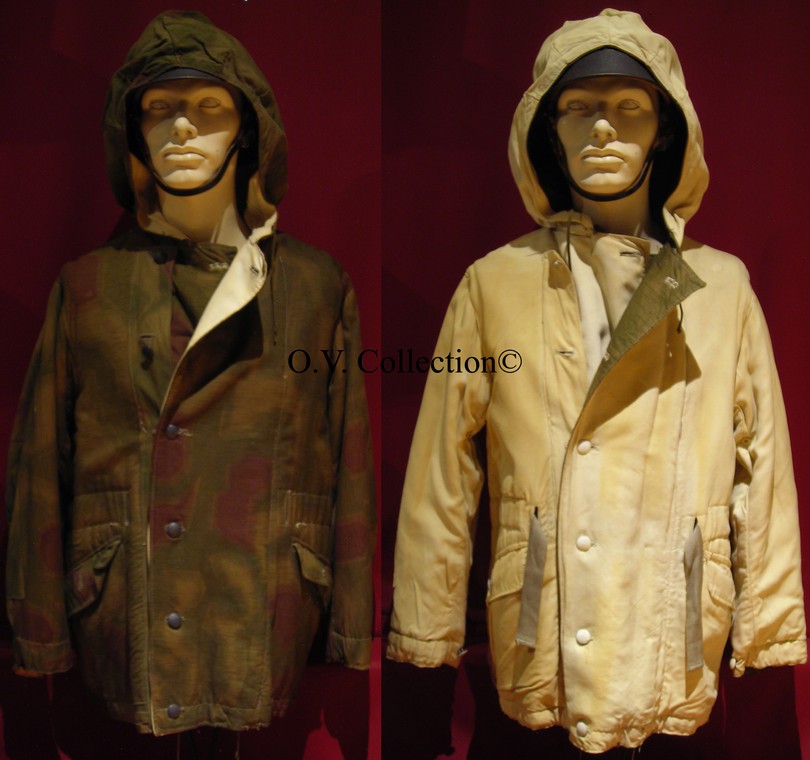Umkehrbare
winteranzug
While "tropical"
equipment for hot climates was well stocked by the time German troops
arrived in North-Africa, Hitler refused to provide the Eastern front
with special winter uniforms assuming victory by then.
As a result the soldiers on the Eastern front faced the winter of
1941/42 without adapted garments, often relying on improvised paper
garments or even civilian ones that were collected and send from
Germany.
Source:
"Osprey #34" & "Winteruniforms of the German army and luftwaffe
in WW2".
 [Hot vs. cold climate
preparations.][Hide]
[Hot vs. cold climate
preparations.][Hide]
|
"Unlike the unfortunate Wehrmacht
soldiers on the Eastern Front who suffered the horrors of the Russian
winter of 1941/42 in clothing suitable only for moderate climates, the
soldiers of the Afrikakorps were well equipped.
As soon as German involvement in the Merditerranean area and Middle
east began to seem likely the Tropical Institute of Hamburg University
was commissioned to develop a range of tropical uniforms, and by late
1940 large stocks were allready available"
Source:
Osprey Elite series #34 "Afrikakorps 1941/43".
"Special equipment items were manufactered for use in North Africa from
late 1940 to 1942 to withstand the rigours of a hot dry climate. For
almost all items of the basic Continental rifleman's equipment there
was a tropical counterpart.
Source:
Osprey Men at arms series #234 "German combat equipment 1939-1945".
"In the summer of 1941, Commanding General Friedrich Paulus repeatedly
asked Adolf Hitler for special winter uniforms. The answer was simple
but nonetheless proofed to be a fatal error. It translates as follows:
"I do not want to hear anymore of those
arguments about the difficulty of supplying our troops during winter.
To have any concerns about this is preliminary, as there will not be
any winter warfare. I hereby prohibit you to further talk to me about
such events".
Source:
"Winteruniforms of the German army and luftwaffe in WW2 by Vincent
Slegers".
|
Winterjacke
43 - Sumpfmuster43
Developed by Josef Neckermann of the still active "textil-versandhaus
Neckermann".
 [Neckermann's Ostkommision]
[Neckermann's Ostkommision]
[Hide]
"Although German High Command
made it appear as if the so-called Wintersonderbekleidung was developed
by their own personnel, it was in fact developed by Josef Neckermann,
owner of the textil-versandhaus Neckermann. After receiving a letter
from his brother Walther in late 1941, who was serving on the Eastern
front, he saw the urgent need for adequate winter clothing".
After founding the so-called Ostkommision, Neckermann and his
associates founded three more commisions to respectivly study soldiers
own expierences and captured Russian garments, develop a new fabric and
test prototypes.
Source:
"Winteruniforms of the German army and luftwaffe in WW2 by Vincent
Slegers".
|
Seen here with the hood
easily covering
a M42 Stahlhelm, the white side was to be worn as little
as possible as it was hard to dry if washed.
 [White side usage &
alternatives
][Hide]
[White side usage &
alternatives
][Hide]
The heavy reversible winter
clothing proved so popular with the
German troops fighting in the east that they tended to wear the uniform
day and night for weeks on end. The white side soon became filthy thus
defeating the object of the white camouflage.
It was impossible for the
troops to wash these garments as the thick blanket lining did not allow
the uniform to dry out. Consequently several alternative capes and suits, made of thin white
cotton that could be easily cleaned and dried, were supplied to the
front.
Source:
German Army uniforms and insignia 1933-1945 by Brian L. Davis, p.181
|

The Modell 43 features rectangular cotton reinforcing patches from
elbow to lower sleeve, the small buttons between
shoulder and elbow could hold coloured bands for
identification.
 [Coloured bands][Hide]
[Coloured bands][Hide]
Bands of coloured cloth were
used by forward German forces to help identify friendly troops.Like
passwords, these bands of cloth were changed every day and a new colour
was used for this purpose.
Source:
German Army uniforms and insignia 1933-1945 by Brian L. Davis, p.179
|

This particular example
has some rare features, most noticably the use of the less common
"fluffy edge" camouflage variant on the back.
The "fluffy edge" is also horizontal (as is the front Sumpfmuster43
fabric), as opposed to the standard vertical way as seen on the sleeves
and hood.
Fäustlinge 43

Marked by a Berlin maker this "43"
version, easily recognizable by the separate index finger, also has
sumpfmuster43 camouflage.



